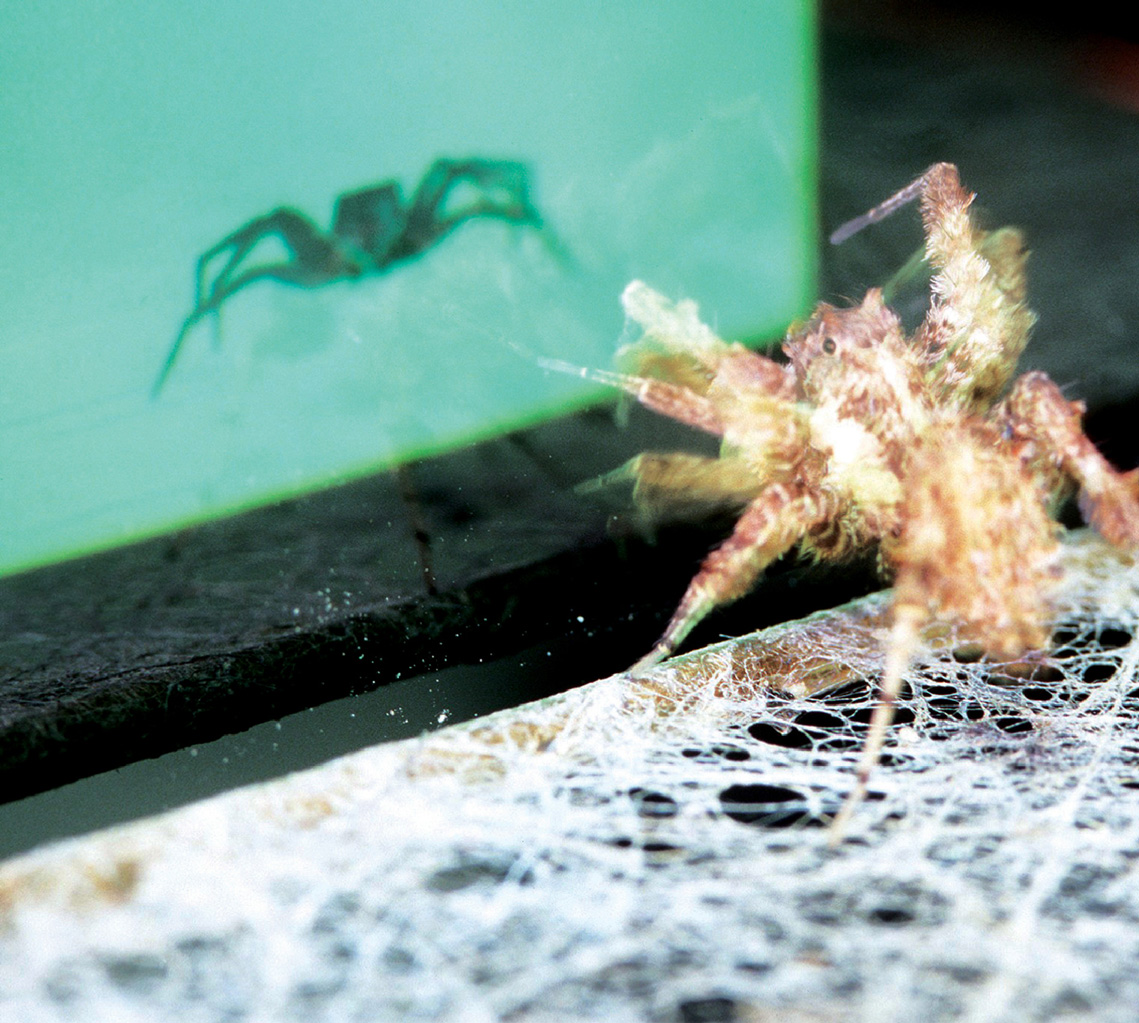Web Media
Watching spiders watch TV
Margaret Wertheim
In the conventional wisdom of the scientific age, a small brain connotes not merely small thoughts, but dull, pallid, vague perceptions, so that when we trample ants with impunity, it is not because we think they are stupid, but rather that we feel confident our violence will barely register in their miniscule minds. Orders of magnitude less complex than ours, the invertebrate mind has routinely been attributed only the most rudimentary perceptions, an estimation shored up by the failure of artificial intelligence systems to mimic many of the most basic mammalian skills. After two decades of intensive research, computer engineers now pride themselves on robots that can navigate a corridor. Image processing, it turns out, is a deeply difficult task and one that was long thought beyond the scope of Arthropoda, a phylum that includes both insects and spiders.
In the 1980s, zoologists were thus astonished to discover that Salticidae, or jumping spiders, a family of the arachnids that contains more than five hundred genera and over five thousand separate species, had vision systems on par with cats, mammals famous for their acute eyesight. With around six hundred thousand neurons in its brain (roughly half that of a fly or a honeybee), a jumping spider can recognize images on a television screen and is the only invertebrate known to be capable of such a sophisticated feat of visual processing. “How does this speck of dust of a brain achieve such a complicated task?” asks Simon Pollard, curator of invertebrate zoology at the Canterbury Museum in Christchurch, New Zealand. “We need to look deep into these unblinking eyes.”

What goes on in the mind of a jumping spider is a subject that is beginning to attract the attention of NASA, whose engineers hanker to program such skills into Mars roving robots. The agency has recently funded a project with Pollard’s colleague Duane Harland of Canesis, a research and development company based in New Zealand. “Our normal understanding of brains doesn’t allow this kind of behavior,” Harland notes. “How do they do it?”
The spider’s brain receives input from a truly remarkable set of eyes. In fact, jumping spiders have four sets of eyes—one at the front for fine perception, and three pairs at the side and back which enable them to perceive motion crudely and quickly in a 360-degree field of view. But it is the two front eyes that command most attention from the researchers. They have studied the spider’s spatial acuity—its ability to resolve two closely spaced lines—and found that where human spatial acuity is 0.007˚, a jumping spider’s is 0.04˚, comparable to that of domestic cats. The spider uses this extraordinary power for prey identification, and around Lake Victoria in Kenya jumping spiders can pick out single mosquitoes from clouds of lake flies so vast that they block out the sun.
Mammals achieve their visual acuity with large spherical eyeballs, but, with a body often less than millimeter long, a jumping spider’s head is too small for such an orb. Instead, the principal eye has the structure of a Galilean telescope—a long tube with lenses at both ends. It is the same strategy adopted by eagles and falcons but on a miniscule scale. The salticid’s principal eye retina covers a mere 0.6˚ and has no more than fifteen hundred receptors, in contrast to the human retina’s two hundred million. This tiny array is organized into four separate color-sensitive layers that respond to different frequencies of light, including ultraviolet. In the backmost layer, the fovea, a densely packed region consisting of just two hundred receptors, is responsible for most of the visual acuity.
Size restrictions pose other challenges too. We humans focus our eyes on different objects by changing the shape of our corneal lenses; a salticid cannot change the shape of its eyes and resorts to other tricks instead. Here, the retinal receptors are arranged in a staircase, and at just about any distance an object will be in focus somewhere on the staircase. All these limitations mean that a jumping spider sees the world just a few pixels at a time and its brain must somehow stitch together an image, or at least an impression of the image, from many small fragments. That it is capable of such a remarkable cognitive feat is demonstrated by its ability to recognize cartoon insects on a miniature television screen. With carefully concocted animations and specially built spider-sized ophthalmoscopes, Harland has been teasing out the specific features that salticids recognize. The team theorize that inside the spider’s brain, the image is pieced together much like a television picture itself as muscles continually move the highly mobile eye-tubes to and fro, scanning over a scene. “If this hypothesis is corroborated,” Harland and Pollard write in a recent paper with Robert Jackson, “then recording the details of eye behavior may be almost like seeing the salticid think.” Far from being the automatons of Cartesian mythology, it is already clear that these tiny minds have astonishing perceptual power.
Margaret Wertheim is founder and director of the Institute For Figuring, a Los Angeles-based organization dedicated to the aesthetic and poetic dimensions of science and mathematics. She is currently working on a book about outsider physics and the role of imagination in theoretical science.
Spotted an error? Email us at corrections at cabinetmagazine dot org.
If you’ve enjoyed the free articles that we offer on our site, please consider subscribing to our nonprofit magazine. You get twelve online issues and unlimited access to all our archives.